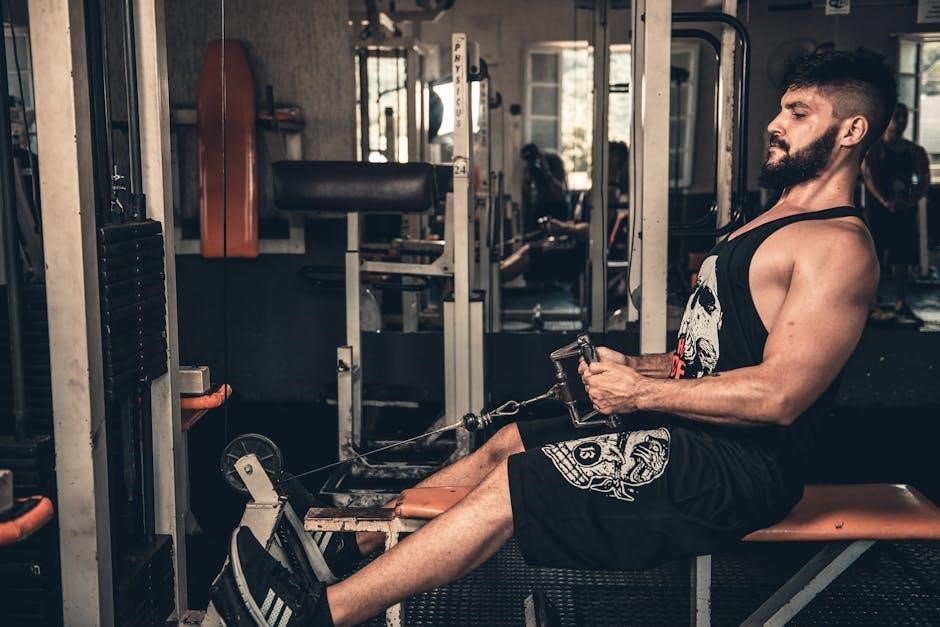The Colorado Experiment, conducted by Arthur Jones with Casey Viator, demonstrated extreme muscle growth using high-intensity, short-duration workouts. This 28-day study showcased rapid gains, sparking interest in efficient training methods.
1.1 Overview of the Experiment
The Colorado Experiment was a groundbreaking 28-day study led by Arthur Jones, focusing on rapid muscle growth through high-intensity, short-duration workouts. Casey Viator, the primary subject, followed a structured routine using Nautilus equipment, training every other day. The program emphasized negative-only repetitions and momentary muscle failure, resulting in significant gains. This experiment showcased the potential of efficient, science-backed training methods to achieve dramatic results in minimal time.
1.2 Key Figures: Casey Viator and Arthur Jones
Casey Viator, a renowned bodybuilder, and Arthur Jones, the founder of Nautilus equipment, were central to the Colorado Experiment. Viator gained 63.21 pounds of muscle in 28 days, while Jones designed the high-intensity, short-duration workouts. Their collaboration demonstrated the potential of focused training and advanced equipment, leaving a lasting impact on strength training methodologies and muscle-building strategies.
Background and History of the Colorado Experiment
Conducted in 1973 by Arthur Jones at Colorado State University, the Colorado Experiment tested high-intensity training using Nautilus equipment, resulting in Casey Viator’s remarkable muscle gains.
2.1 The Setup at Colorado State University
The Colorado Experiment was conducted at Colorado State University in May 1973, utilizing Nautilus equipment to focus on high-intensity, short-duration workouts. Arthur Jones oversaw the study, which involved Casey Viator training every other day. The setup included controlled conditions to maximize muscle growth and strength gains, with workouts lasting under 30 minutes. This environment allowed for precise monitoring of Viator’s progress and adherence to the training protocol.
2.2 The Role of Nautilus Equipment
Nautilus equipment played a pivotal role in the Colorado Experiment, providing specialized machines that isolated muscles and emphasized high-intensity training. The equipment allowed for controlled, precise movements, enabling Casey Viator to focus on negative-only repetitions and achieve muscle failure efficiently. Some machines were prototypes designed exclusively for the experiment, offering unique training dynamics that contributed significantly to the study’s remarkable results and rapid muscle growth.

Training Methodology
The Colorado Experiment focused on high-intensity, short-duration workouts, emphasizing negative-only repetitions and an every-other-day schedule to maximize muscle growth and recovery within the 28-day period.
3.1 High-Intensity, Short-Duration Workouts
Casey Viator performed brief, intense workouts under 30 minutes, focusing on high-intensity exercises like leg presses and squats. Each session targeted full-body muscle engagement, with minimal rest periods. The routine emphasized single sets to muscle failure, achieving remarkable results in just 28 days. This approach highlighted the effectiveness of short, intense training for rapid muscle growth and strength gains, supervised by Arthur Jones in a controlled environment.
3.2 Focus on Negative-Only Repetitions
The Colorado Experiment emphasized negative-only repetitions, where the lowering phase of exercises was prolonged to increase muscle fatigue. Casey Viator performed exercises like leg presses and squats, focusing on slow, controlled descents to maximize muscle engagement. This technique, combined with high-intensity efforts, contributed to rapid muscle growth and strength gains, highlighting the effectiveness of this unique training approach in the experiment’s short duration.
3.3 Workout Schedule: Every Other Day Routine
The Colorado Experiment followed an every-other-day workout schedule, allowing for optimal recovery between sessions. Casey Viator trained every other day, enabling his muscles to repair and grow effectively. This schedule, combined with high-intensity workouts, contributed to significant muscle gains over the 28-day period. The routine balanced intense training with adequate rest, making it a key factor in achieving the experiment’s remarkable results.

Diet and Nutrition During the Experiment
Casey Viator followed a strict diet with caloric intake below 800 calories daily for six weeks pre-experiment. His diet focused on specific macronutrient ratios to maximize muscle growth.
4.1 Caloric Intake and Restrictions
During the Colorado Experiment, Casey Viator adhered to a severely restricted diet, consuming fewer than 800 calories daily for six weeks prior to the study. This drastic caloric deficit was designed to minimize body fat, allowing for precise measurements of muscle growth. The controlled nutrition plan emphasized protein-rich foods to support muscle synthesis while maintaining a state of caloric restriction.
4.2 Macronutrient Breakdown for Muscle Growth
The Colorado Experiment emphasized a macronutrient breakdown tailored for muscle growth, focusing heavily on high protein intake to support muscle repair and synthesis. Carbohydrates were kept low to maintain a caloric deficit, while fats were minimized to optimize fat loss. This precise balance of nutrients was crucial for achieving the experiment’s goal of rapid muscle gain in a controlled, short-term period.

Results and Outcomes
The Colorado Experiment yielded remarkable results, with Casey Viator gaining 63.21 pounds of muscle in 28 days. Strength increases were equally impressive, showcasing the effectiveness of the high-intensity training methodology.
5.1 Muscle Gain Achievements
Casey Viator achieved extraordinary muscle growth, gaining 63.21 pounds of muscle in 28 days. This remarkable result, supervised by Arthur Jones, challenged conventional beliefs about muscle gain limits. The experiment’s high-intensity, short-duration workouts proved remarkably effective, with significant increases observed from the first week onward, making it one of the most talked-about studies in strength training history.
5.2 Strength Increases and Progression
Casey Viator’s strength gains were remarkable, with significant progression in key lifts like leg presses and squats. Over 28 days, he achieved substantial increases in poundage, demonstrating the effectiveness of high-intensity, short-duration workouts. Arthur Jones’ supervision ensured consistent progression, with strength gains mirroring the impressive muscle growth, validating the experiment’s innovative training approach and its ability to rapidly enhance muscular power and endurance.
Implementing the Colorado Experiment Routine
To replicate the Colorado Experiment, focus on high-intensity workouts with Nautilus equipment, following an every-other-day schedule. This approach maximizes recovery and muscle growth efficiently.
6.1 Required Equipment and Setup
The Colorado Experiment relied heavily on Nautilus equipment, including machines designed for negative-only reps. While original machines are rare, modern adaptations can use free weights and conventional gear. A well-equipped gym setup is essential, focusing on exercises that target major muscle groups. Proper form and safety measures are crucial to avoid injury and ensure effective workouts. Consistency and adherence to the routine are key for optimal results.
6.2 Tips for Replicating the Workout Plan
To replicate the Colorado Experiment, focus on high-intensity, short-duration workouts with adequate rest days. Prioritize negative-only repetitions and ensure proper form to avoid injury. Stick to the every-other-day schedule and maintain consistency. Incorporate compound movements targeting major muscle groups, and consider using free weights or conventional machines if Nautilus equipment is unavailable. Dedication and adherence to the 28-day plan are crucial for achieving significant results.

Criticisms and Controversies
The Colorado Experiment faced skepticism due to its extraordinary results, with critics questioning the accuracy of muscle gain claims and citing Casey Viator’s exceptional genetics as a factor.
7.1 Skepticism About the Results
The Colorado Experiment’s claims of rapid muscle gain sparked skepticism, with many questioning the legitimacy of such extreme results in a short time. Critics argued that the 63-pound muscle gain was unrealistic and likely inflated. The unavailability of the specific Nautilus equipment used and Casey Viator’s exceptional genetics further fueled doubts. Additionally, the experiment’s controlled environment and lack of peer-reviewed publication raised concerns about its scientific validity and potential bias toward promoting Nautilus products.
7.2 Genetic and External Factors
Casey Viator’s exceptional genetics were a significant factor in the Colorado Experiment’s outcomes. His unique genetic predisposition for muscle growth, combined with the controlled environment and specialized Nautilus equipment, contributed to the remarkable results. External factors, such as the tailored training and nutrition plan, also played a role. These elements make the experiment’s results difficult to replicate, as they are highly dependent on individual genetics and specific conditions, limiting broader applicability.
Real-World Applications and Variations
The Colorado Experiment’s principles are now adapted into modern fitness routines, emphasizing efficient, high-intensity workouts. Trainers and enthusiasts modify the approach to suit individual goals and equipment availability, making it a versatile and enduring training philosophy.
8.1 Modern Adaptations of the Routine
Modern adaptations of the Colorado Experiment focus on integrating high-intensity, short-duration workouts into contemporary training plans. Trainers now use a mix of free weights, conventional machines, and advanced equipment to replicate the routine. The emphasis remains on negative-only repetitions and efficient rest periods, but the approach is tailored to individual goals and availability of equipment, making it more accessible and versatile for today’s fitness enthusiasts.
8.2 Incorporating the Principles into Other Training Plans
Coaches and athletes integrate Colorado Experiment principles into diverse training plans by emphasizing high-intensity, short-duration workouts and negative-only repetitions. Modern programs often combine these methods with periodization and flexibility exercises, allowing for balanced development. This approach enables athletes to maximize strength and muscle growth without adhering strictly to the original routine, making it a versatile tool for achieving various fitness objectives effectively.
The Colorado Experiment highlights the power of high-intensity training and adequate rest for rapid muscle growth, influencing fitness communities and underscoring the role of genetics and consistency.
9.1 Final Thoughts on the Colorado Experiment
The Colorado Experiment remains a fascinating study in high-intensity training and muscle growth. While its results are debated, the focus on efficient, short workouts and recovery highlights its significance. Casey Viator’s remarkable gains underscore the potential of targeted training, though replicating such results is challenging. The experiment’s legacy lies in its innovative approach, influencing modern fitness practices and sparking discussions on training methodologies and genetic factors.
9.2 Recommendations for Fitness Enthusiasts
For those inspired by the Colorado Experiment, consider adopting its principles of high-intensity, short-duration workouts. Focus on proper form and gradual progression to avoid injury. Consult a fitness professional to tailor the routine to your goals and fitness level. Consistency and patience are key, as muscle growth requires time. Combine the workout with a balanced diet and adequate recovery for optimal results. Experiment wisely and stay committed to your fitness journey.